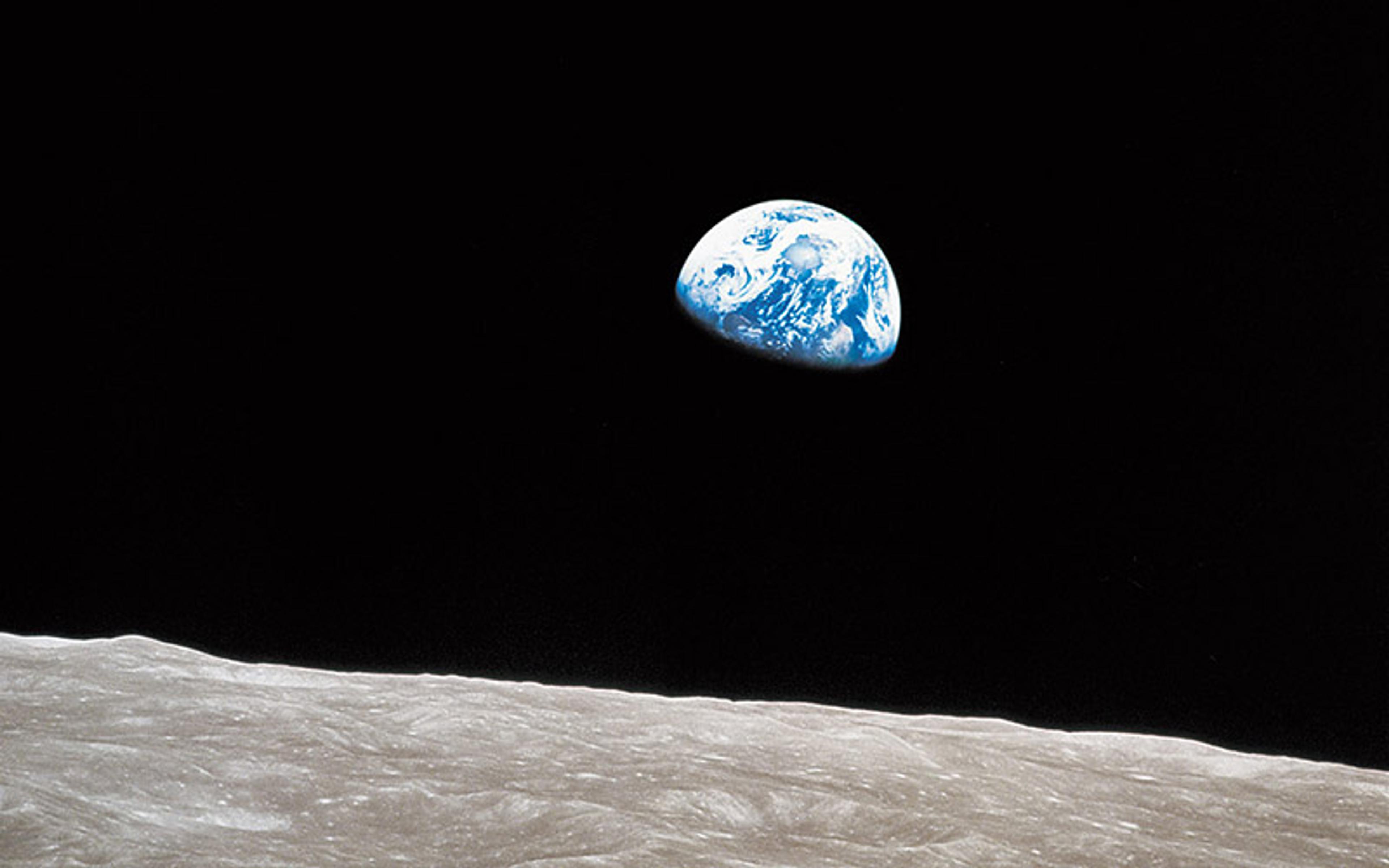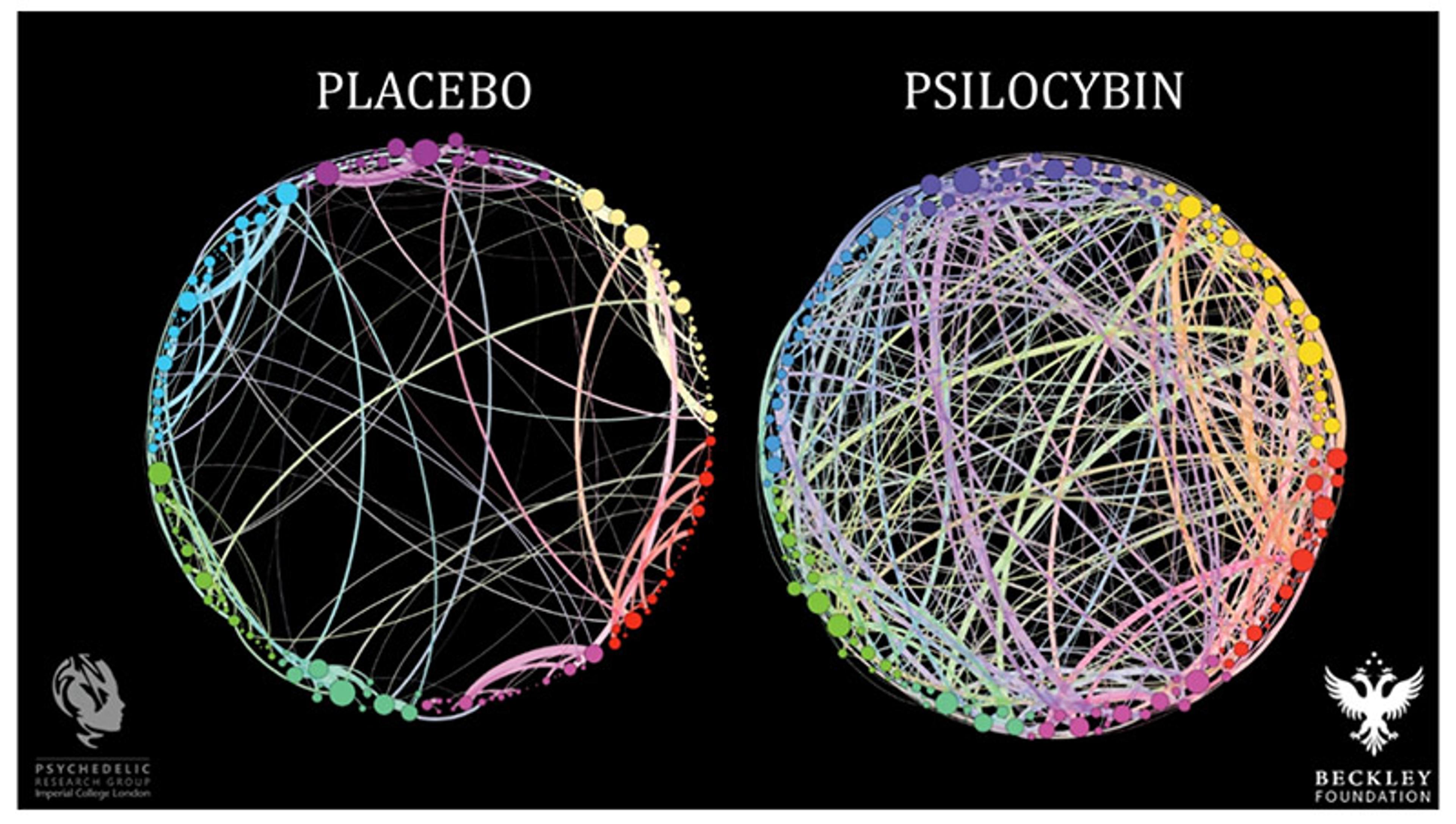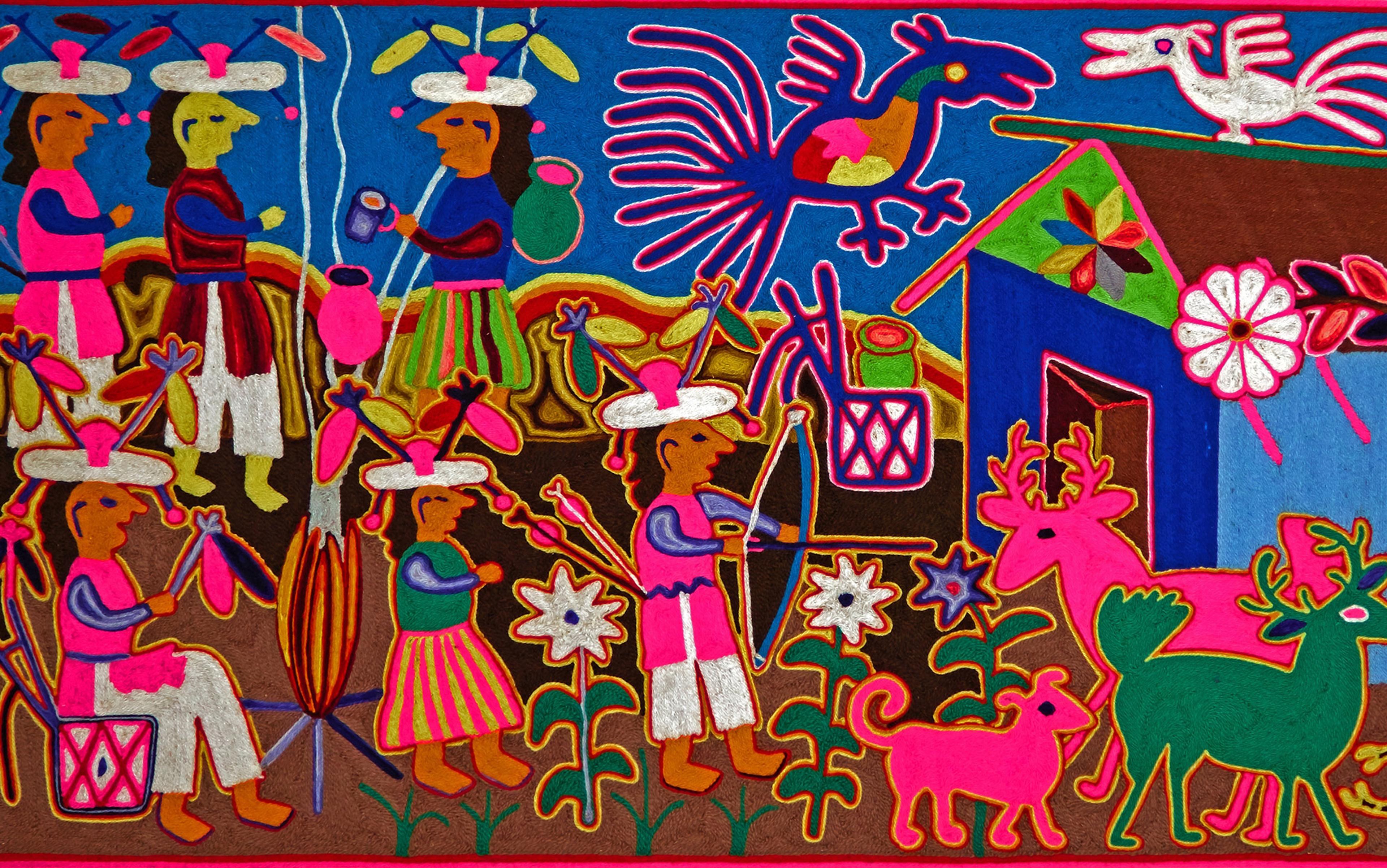In 1966, on a rooftop overlooking San Francisco, the writer Stewart Brand felt that he could perceive the curvature of the Earth, an effect of the psychedelic substance he had consumed. He wondered why no one had photographed the Earth from space yet, and realised how much this might help people feel connected to each other and to their shared home. Later that day, he wrote in his journal: ‘Why haven’t we seen a photograph of the whole Earth yet?’ Next day, he ordered hundreds of posters and badges to be made, demanding the answer to his question, in a campaign that quickly went viral across the United States.
Just a couple of years later, on Christmas Eve 1968, the NASA astronauts Frank Borman, Jim Lovell and William Anders were aboard Apollo 8, the first manned mission to orbit the Moon. They had spent most of the day photographing the Moon’s surface, when Borman turned the spaceship around, and Earth came into view. ‘Oh my God, look at that picture over there. Here’s the Earth coming up,’ shouted Anders. Like the astronauts themselves, the world was awestruck by the first images of the whole Earth from space, which are today widely credited with triggering the birth of the modern environmental movement.

The Apollo 8 Earthrise photograph from 1968. Courtesy NASA
As these two examples show, momentous shifts in perspective can come from fleeting moments of epiphany such as those experienced by Brand or the crew of Apollo 8.
Astronauts who have seen the Earth from space frequently describe a profound cognitive shift. ‘The vast loneliness is awe-inspiring, and it makes you realise just what you have back there on Earth,’ said Lovell, part of the crew of both Apollo 8 and Apollo 13. Researchers call this kind of shift in perspective the ‘overview effect’: a breakthrough shift in perspective catalysed by the perception of the unity and interconnectedness of life on Earth, often resulting in a strong desire to protect the planet.
And as Brand’s experience underscores, something very similar can be triggered by experiences with psychedelic substances. Psychedelics can unlock a newfound appreciation of nature, a profound sense of being part of a much larger whole and of a magnificent interconnected web of life – something that has been described again and again in experience reports, research surveys, experimental studies and historical accounts of early psychedelic experiences.
Yet psychedelics were prohibited in many countries shortly after the Earthrise photograph was taken, starting in the United States with the then president Richard Nixon’s Controlled Substances Act of 1970, which outlawed substances such as LSD, psilocybin and DMT. Years of fruitful research into the psychotherapeutic potential of psychedelics came to a sudden, juddering halt, leaving a tantalising question in their wake: would the ecological literacy of our species have developed differently had these tools for glimpsing the ‘overview’ been safeguarded rather than outlawed?
The upshot, it seems, has been an ‘underview’ effect, defined by technology and the disconnected self. All of us need a sense of ego. A sense of ‘self’, marked by a feeling of separateness, means that we can attend to personal safety and take care of our own needs. But while a healthy level of ego is protective, an unhealthy level rapidly becomes a prison. We get trapped in our heads, and disconnected from our bodies, feelings and senses. We become unable to empathise with other people and the world around us; our perspective narrows; we see fragments of the world and our place in it rather than the whole.
Today, two of the most pressing threats of our time – the growing tribalism of our politics and the looming ecological collapse as we approach and exceed safe planetary boundaries – can both be understood as consequences of just such a narrowing viewpoint; an ‘underview’ effect, if you will.
Start with the idea of a ‘separate self’ that has become central to Western societies over the past five centuries – from the Enlightenment’s emphasis on rigid lines between mind and matter, or humans and nature, all the way through to contemporary trends such as consumerism, falling social capital and status anxiety. Even as our technological interconnection increases, our connections to our inner lives, each other and our shared home have become weaker and more sparse.
The costs have proven steep. Loneliness is spiking, with a quarter to a third of people in Britain reporting that they always or often feel lonely, left out or isolated; and rates of loneliness are highest among those aged 16-24. The public-health impacts of the trend are dramatic, with research suggesting that loneliness is as harmful to life expectancy as smoking, and worse than obesity.
At the same time, screen addiction is rampant. In the US, adults on average now spend nearly four hours a day on their phones, plus nearly five more watching television. For much of this time, we are either being targeted by advertisers, who have become adept at playing on our fears about our own self-worth, or advertising ourselves to others, through obsessively curated images of our bodies and our lives shared on Facebook or Instagram. Here too, the effects on health and wellbeing are disastrous, with anxiety, self-harm and suicide all at historically high levels, particularly among the young.
Climate change and mass extinction can only be solved if societies come together
Meanwhile, we also spend less time in nature, as well as less time with each other. A survey in 2016 found that 74 per cent of children in the UK now spend less than an hour a day playing outside, less than the UN-mandated minimum for prison inmates. Another survey found that children in the UK are more able to identify Pokémon characters than common wildlife species. This retreat from nature brings its own mental-health toll, given that spending time in nature and feeling connected to it is strongly correlated with wellbeing, vitality and life satisfaction.
The effects of disconnection, individualism, loneliness and social-media addiction are also increasingly playing out in the political space, where the rise of polarisation and tribalism has led many analysts to become increasingly concerned about the breakdown of common ground and the ability of societies to feel a shared sense of identity and purpose.
In countries all over the world, politics looks increasingly ‘triggered’, as anxiety and threat-perception ripple easily through our collective digital central nervous system. This, in turn, creates a situation full of opportunity for political populists and authoritarian leaders who have become increasingly adept at using a mixture of psychology, technology and communications expertise to push voters to see the world from the perspective of them-and-us, potentially swaying the outcomes of elections.
Meanwhile, political polarisation also prevents us from responding to some of the toughest and most urgent challenges humans have ever faced, such as climate change and mass extinction, which can only be solved if societies come together with strongly shared purpose and intention.
We are at a moment of profound crisis but also far-reaching opportunity. Much depends on whether enough of us can deepen our empathy for each other, build our sense of common purpose, and identity with a ‘larger us’ – one that includes all the world’s 7.5 billion (and rising) people, as well as other species and generations as yet unborn.
The key to connectedness could be psychedelics. While our culture might regard nature as a ‘thing’ to be enjoyed or exploited rather than a living system to protect, indigenous communities tend to take a different view. Nature connectedness and stewardship lies at the heart of Wixáritari (Huichol) culture in Mexico, where a sense of self encompasses their community and homeland. Not coincidentally, the Wixáritari, whose ancient rituals include the peyote cactus, are also the most longstanding, culturally intact group on Earth to use psychedelics. These experiences likely played a key role in maintaining their harmonious way of living as part of an interconnected ecosystem.
Contemporary scientific research is now increasingly confirming the potential that psychedelics have for creating deep connection both between people, and between humans and the ecosystems they inhabit.
For example, in a small but noteworthy clinical trial of psilocybin as a treatment for depression, 85 per cent of participants experienced significant reductions in their symptoms, and an increased sense of connectedness was commonly reported by those whose depression symptoms improved. In another trial, of those participants who experienced significantly reduced depression, 94 per cent described feeling a new sense of connection to the world around them, with the same number reporting increased connection to other people even up to a year later.
Significantly, deeper ‘connection to self’ was also frequently reported – but rather than implying connection to the ‘ego self’ (the thinking mind, self-preservation, fear), participants reported connection to an expanded sense of the ‘true’ self that incorporates emotions and intuition, and is guided by meaning, purpose, empathy and compassion.
Similarly, modern research is adding scientific weight to the hypothesis that psychedelics are tools for enhancing ‘biophilia’, a term popularised by the biologist E O Wilson in the 1980s to mean an innate human tendency to seek connection to nature and appreciate other forms of life. In a recent survey of 150 psychedelics users, everyone reported that biophilia was enhanced. Likewise, a meta-analysis of eight double-blind placebo-controlled studies found that more than a third of participants taking psilocybin reported enduring positive changes in their relationship to the environment 8 to 16 months after taking the drug. The increase in connection to nature appears to be an enduring shift in perspective, one noted in other studies examining the long-term effects of psilocybin. At Imperial College, researchers found a marked increase in measures of nature-relatedness post psilocybin; the effect was sustained at least a year after the experience.
‘From where you see it, the thing is a whole, and it’s so beautiful’
Intriguingly, the words used by participants themselves to describe their insights bear a striking similarity both to Brand’s rooftop epiphany and to the words used by astronauts to explain their sense of ‘overview’ during and after space missions. For example, among the descriptions offered by participants in a study by Imperial College London in 2017 were the following:
I was everybody, unity, one life with 6 billion faces … I was swimming in the sea, and the sea was me.
Like Google Earth, I had zoomed out … I was absolutely connected to myself, to every living thing, to the Universe.
I got a wider perspective, I stepped back. It helped me appreciate that the world is a big place.
Compare these with two descriptions of ‘overview’ experiences given by astronauts:
You identify with Houston and then you identify with Los Angeles and Phoenix and New Orleans … When you go around the Earth in an hour and a half, you begin to recognise that your identity is with that whole thing … From where you see it, the thing is a whole, and it’s so beautiful. You wish you could take one in each hand, one from each side of the various conflicts, and say: ‘Look. Look at it from this perspective. Look at that. What’s important?’
– Russell Schweickart, Apollo 9, quoted in The Overview Effect (1987) by Frank White
As we rotated, I saw the Earth, the Sun, the Moon, and a 360-degree panorama of the heavens. The magnificence of all of this was this trigger in my visioning. In the ancient Sanskrit, it’s called Samadhi. It means that you see things with your senses the way they are – you experience them viscerally and internally as a unity and a oneness accompanied by ecstasy. All matter in our Universe is created in star systems, and so the matter in my body, the matter in the spacecraft, the matter in my partners’ bodies, was the product of stars. We are stardust, and we’re all one in that sense.
– Edgar Mitchell, Apollo 14, quoted in his obituary by the Institute of Noetic Sciences
How, then, do psychedelics produce these powerful experiences that create such deep senses of connection, awe and wholeness?

Courtesy the Beckley Foundation/Imperial College
The image above, produced as part of a collaboration between the UK think tank the Beckley Foundation and Imperial College London, depicts increased interconnectivity of the brain under a high dose of psilocybin compared with a placebo, measured via functional magnetic resonance imaging (fMRI). Under psilocybin, a brain network called the default mode network (DMN), which is a fundamental component of the neural basis of the ego, is relaxed and deactivated – which enables an increase in brain communication, and temporarily creates a more unified and interconnected brain.
This experience is termed ‘ego dissolution’ because the sense of self as ‘separate’ can dissolve. This, in turn, could explain the kind of self-other and self-nature ‘overlap’ that psilocybin can provoke. Although not all psychedelic experiences bring about full ‘ego dissolution’, when it does occur it can instigate ‘mystical’ or ‘peak’ experiences linked to enduring positive changes in attitudes, behaviour and mood.
Significantly, the deactivation of the DMN is only temporary, and current research is exploring longer-term effects of psilocybin on the brain. It might be that increased brain interconnectivity provides a ‘window of opportunity’ before the brain goes back to a more rigid state again. Indeed, most participants in the study of psilocybin for depression reported that their symptoms returned after a few months. However, even after the feeling of interconnectedness diminished, the unforgettable memory of having ‘seen the bigger picture’ remained.
As humanity faces the bleak prospect of climate breakdown and the sixth mass extinction in Earth’s history – but the first to be attributable to a single species – we urgently need tools that can catalyse shared purpose in protecting and restoring our world. Casual appreciation and enjoyment of nature will not suffice.
The whole arc of human history is about identification and cooperation with ever-larger collectives
Research has already shown that experience with psychedelics strongly predicts an increased sense of connection to nature, and self-reported engagement with pro-environmental behaviours. Albert Hofmann, the scientist who first synthesised LSD in 1938, was well aware of psychedelics’ potential to transform attitudes to nature, writing shortly before his death in 2008, aged 101, that:
Alienation from nature and the loss of the experience of being part of the living creation is the greatest tragedy of our materialistic era. It is the causative reason for ecological devastation and climate change. Therefore I attribute absolute highest importance to consciousness change. I regard psychedelics as catalysers for this.
In many ways, this kind of breakthrough can be best understood as the essential next step in human evolution. The whole arc of human history is about identification and cooperation with ever-larger collectives and levels of complexity: from Neolithic tribes to chiefdoms, from city-states to kingdoms, from nation-states to global diasporas and, just 50 years ago, the first photograph of Earth from space imagined by Brand on his San Francisco rooftop.
At this moment, humanity appears to be teetering between breakdown and breakthrough. A breakdown scenario would see us fragment into multiple smaller groupings as the primacy of disconnected selves and them-and-us politics gathers pace, with catastrophic results given our global interdependence and the scale of the challenges we face.
Breakthrough, by contrast, would see humanity jump to the much higher level of coherence needed to manage planetary-level problems, for all of us and for generations to come – much as earlier phases of evolution saw the emergence of novel complex systems from cells to organs, and from neurons to brains.
The most important variables that will tip the balance between these two scenarios are psychological, above all how we see ourselves and each other, whether we feel connected or threatened, and the size of the collective with which we identify. Not all of us can go to space to experience the overview effect that made such a powerful impact on astronauts in the Apollo programme. But the recent resurgence in psychedelic treatments offers powerful hope for the emergence of an alternative route to a similar destination.
A note from the authors: while psychedelic sessions can be highly beneficial, they can also be extremely challenging, and they should not be taken illegally or without experienced professionals able to guide users through the experience.






